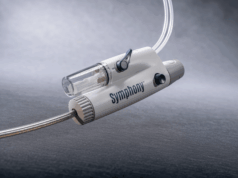
The outcomes from a study that sought to evaluate safety and efficacy of concurrent combination therapy using the AngioJet Rheolytic Thrombectomy (RT) System (Possis Medical) with thrombolytic infusate in patients with deep vein thrombosis (DVT), has concluded that new technique safely and effectively removes blood clots in the body faster, reducing patient risk for pulmonary embolism and disability. Moreover, the study demonstrated that the treatment also had a positive impact on patients’ quality of life, relieving symptoms such as pain and swelling, as well as greatly improving their ability to be active.
Reporting the results at the Society of Interventional Radiology’s 32nd Annual Scientific Meeting, in Seattle, WA, Dr Mark J Garcia, Christiana Care Health System, Wilmington, DE, commented that the new combination technique offers a ‘significant advancement’ in the treatment of DVT, often allowing the interventional radiologists to break up the clot in one treatment. “It has worked on even the largest, most difficult clots and could become the new standard technique, potentially changing the way all DVT patients are treated,” he added.
The ‘rapid lysis’ technique combines a clot-dissolving drug with a clot removal device. The physician uses imaging to guide a catheter and the device into the vein and advances it to the blood clot. The device then sprays a diluted clot-dissolving drug into the clot at high force, helping to break up the clot and deliver the drug to a larger surface area throughout the clot. This enables the drug to remove the clot more quickly and efficiently. A powerful saline jet within the device creates a vacuum that draws the clot into the catheter, thus removing it from the body as the catheter is withdrawn. The physician pulls back the device in a spiral motion, which allows for greater removal of clot.
The invesitgators undertook a retrospective analysis of 102 patients (mean age 47 years, 62% male, 38% female) in 118 cases with large volume DVT and average duration of symptoms 11 days (1-90 days). These patients underwent treatment with the ‘rapid lysis’ technique between August 1999 and July 2006. DVT location included inferior vena cava in 22 patients, iliac in 71, femoral in 80, popliteal in 54 and upper extremity in 15. Either Activase (25mg/1000mL NSS for Xpeedior or 10mg/500mL NSS for DVX) or Retavase (10U/1000mL NSS) infusate was used during RT. A pullback spiraling technique of the Angiojet catheter during thrombectomy was performed via an angled guide catheter. The guide and RT catheters were retracted through the entire clot. Serial venography was performed with additional passes made in areas of residual clot as needed. Underlying lesions were treated with angioplasty and stenting, and catheter-directed thrombolysis was performed at the discretion of the operator. Upon completion, the patient was given standard anticoagulation. Follow-up Doppler examination and QOL assessment were performed at discharge to >1 year.
The results showed that 51% of the patients treated had complete clot removal as well as restoration of blood flow and 31% of the patients had a substantial amount (59%) of the clot removed with blood flow restored. A total of 11% had partial and 4% had minimal clot removal. Forty-three percent of patients were completed at the initial setting and did not need further infusion of medicine to dissolve clot. Follow-up ultrasound exams at six months showed 78% veins to be open with no DVT and 83% open at 12 months with no DVT. The quality of life survey, up to one year, showed that since treatment, 68% had no pain, 67% had no more swelling and 78% no longer had heat or burning discomfort.
Garcia discovered that the treatment worked on the largest, most difficult clots, allowing resolution of DVT quickly and safely while restoring blood flow in the vein. The treatment can reduce the length of a hospital stay, thus reducing costs. The current standard catheter-directed thrombolysis treatment uses a clot-dissolving drug only and, although highly effective, can take two to four days to work. This increases the patients’ risk of bleeding as well as increasing their stay in the ICU. Although the catheter-directed thrombolysis technique has been available for about a decade, many DVT patients don’t receive it. Instead, many patients are treated with blood thinners alone which can help prevent a life threatening pulmonary embolism, but do not help dissolve the clot. Long-term studies show that 50% of people with leg DVT treated with blood thinners alone develop post-thrombotic syndrome, characterised by chronic leg pain and swelling which can lead to skin thickening and ulceration.
“Post-thrombotic syndrome is a common complication of DVT that is under-recognised and potentially preventable if we are able to dissolve the clots early, before permanent damage to the vein occurs,” commented Garcia. “If we treat these patients within 14 days of their onset of symptoms, we are very successful in clearing the clot. Because the treatment is more rapid, safe and effective, patients are more likely to receive it and prevention of permanent damage is more likely to occur.
“Being able to restore blood flow once the clot is removed is imperative to ensuring the long-term success of this treatment. As long as the vein is open and blood freely flows, there is less likelihood the patient will develop another clot,” concluded Garcia.









